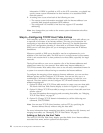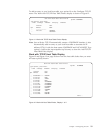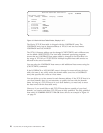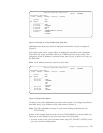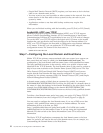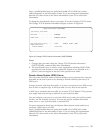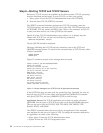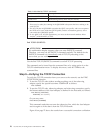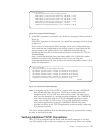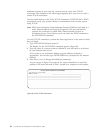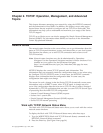
Table 3. Jobs Used by TCP/IP (continued)
Job Name Description
ADMIN and DEFAULT ICS (HTTP) server
QTWSGxxxxx Workstation gateway (there may be several)
Note:
1. There may be other jobs running in the QSYSWRK subsystem that have nothing to do
with TCP/IP.
2. The TCP/IP jobs in QSYSWRK run under the QTCP user profile, with two exceptions:
the TFTP server runs under the QTFTP profile, and the workstation gateway server
runs under the QTMTWSG profile.
3. To use APPC over TCP/IP applications, you must set the network attribute Allow
AnyNet
®
(ALWANYNET) to *YES.
End TCP/IP (ENDTCP):
ATTENTION!
No confirmation display appears when you enter ENDTCP is entered.
Therefore, you must use the ENDTCP command carefully. The default for the
ENDTCP command is to immediately end all TCP/IP processing on the
server that you are working on.
Use the End TCP/IP (ENDTCP) command to end all TCP/IP processing.
The command can be issued from the command line or by using option 4 on the
TCP/IP Administration menu. To display this menu, enter GO TCPADM on the
command line.
Step 9—Verifying the TCP/IP Connection
To verify the TCP/IP connection from your server to the network, use the PING
(VFYTCPCNN) function.
1. To test the TCP/IP code without sending anything out of the token-ring
adapter, specify the special host name LOOPBACK as follows:
PING LOOPBACK
2. To test the TCP/IP code, token-ring adapter, and token-ring connection, specify
the Internet address of the local adapter, as defined in the host table, as follows:
PING RMTSYS(*INTNETADR)
INTNETADR('9.4.73.212')
Or you may enter:
PING RMTSYS(SYSNAM890)
This command sends data out onto the token-ring line, which the local adapter
receives again as if the data is from the TCP/IP network.
Figure 18 on page 27 shows the results from a successful connection verification.
26 OS/400 TCP/IP Configuration and Reference V5R1



